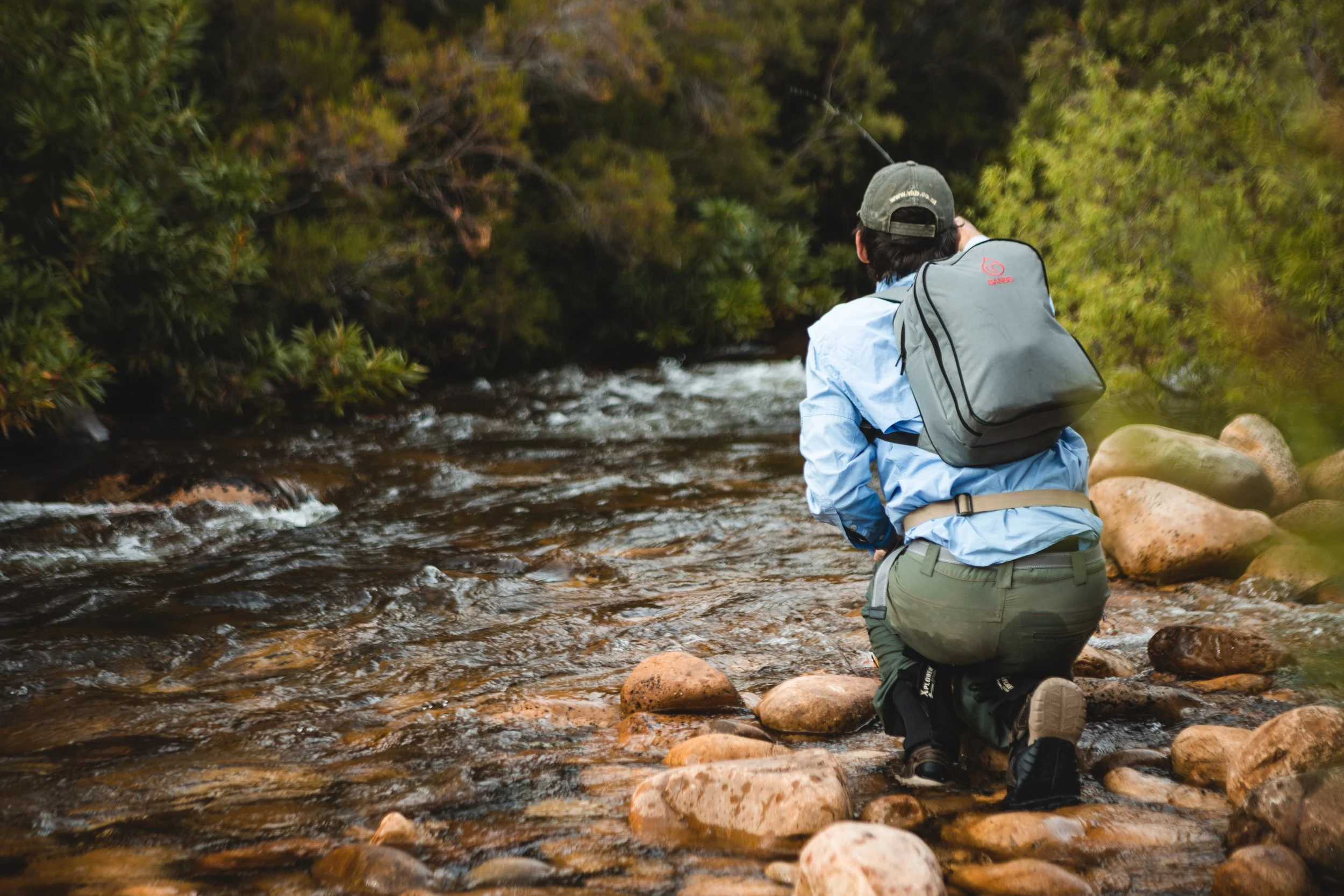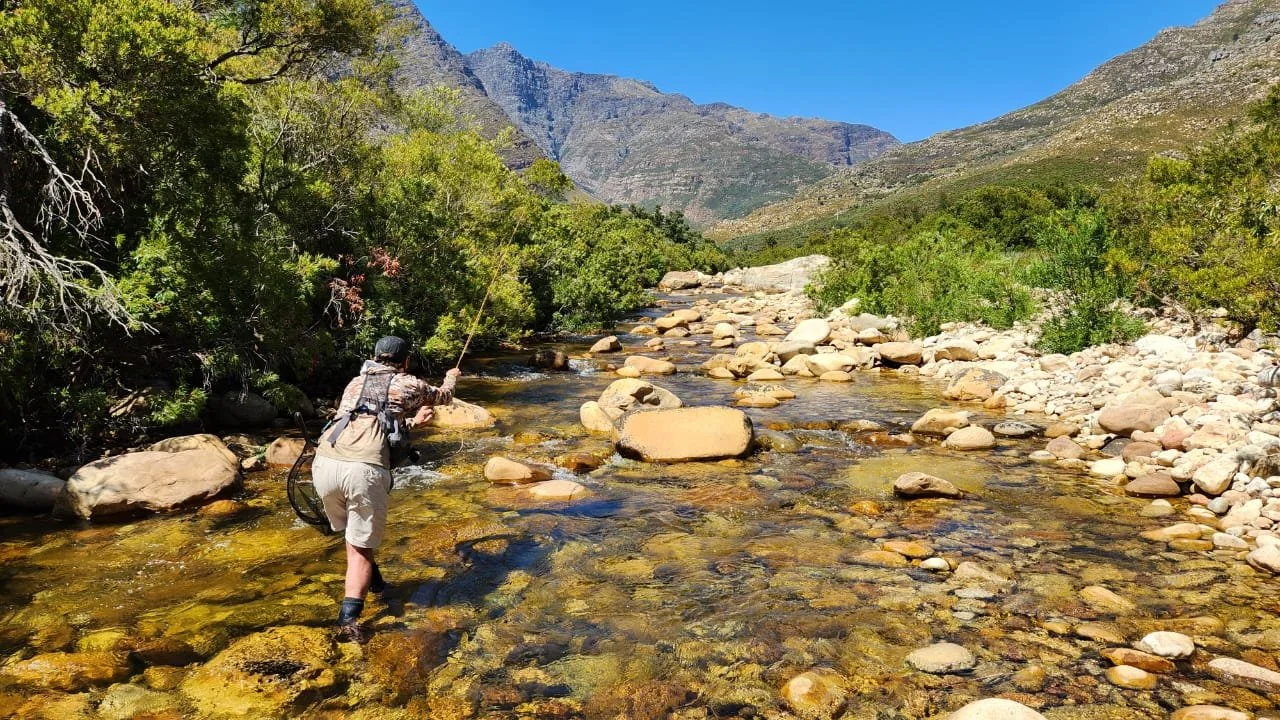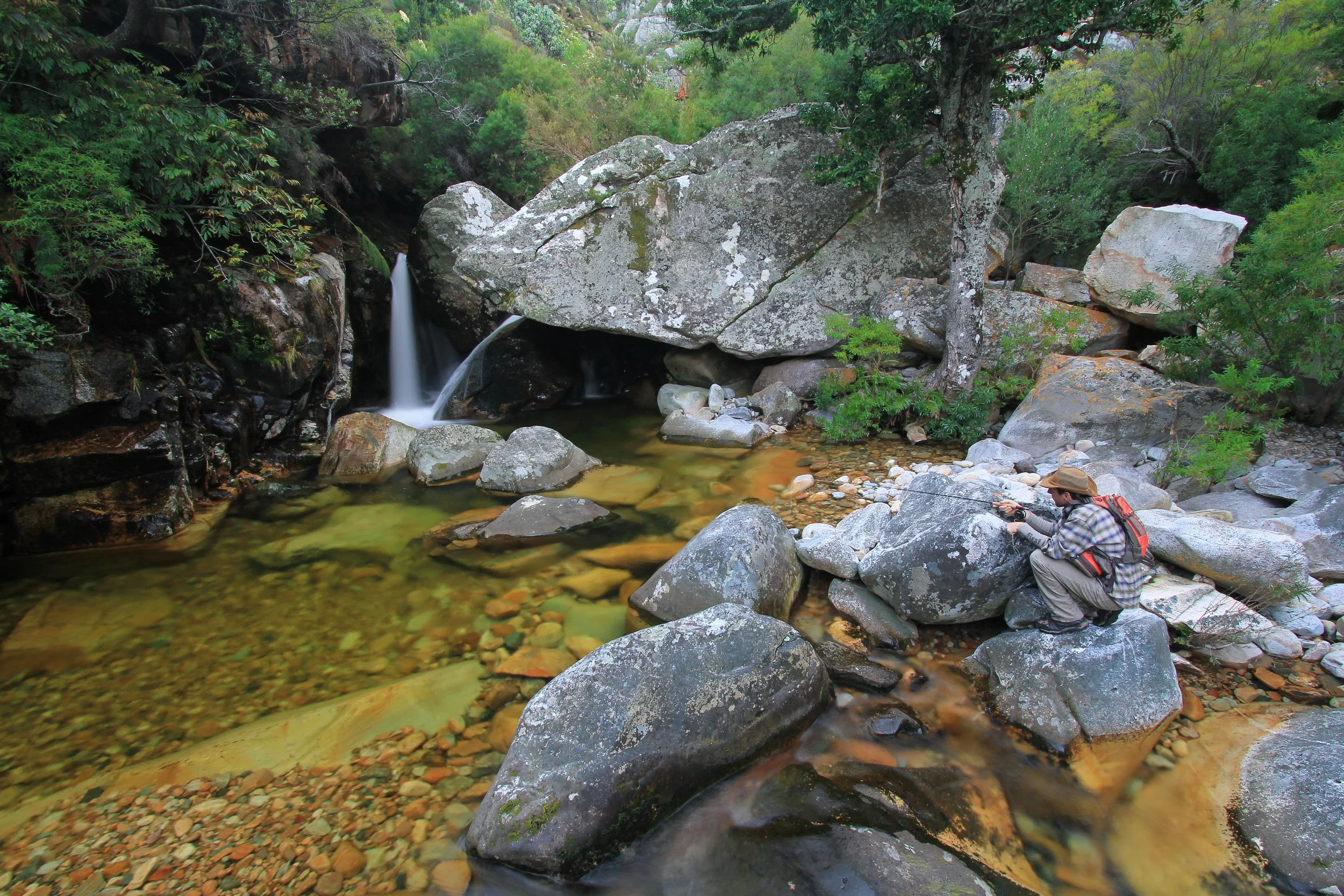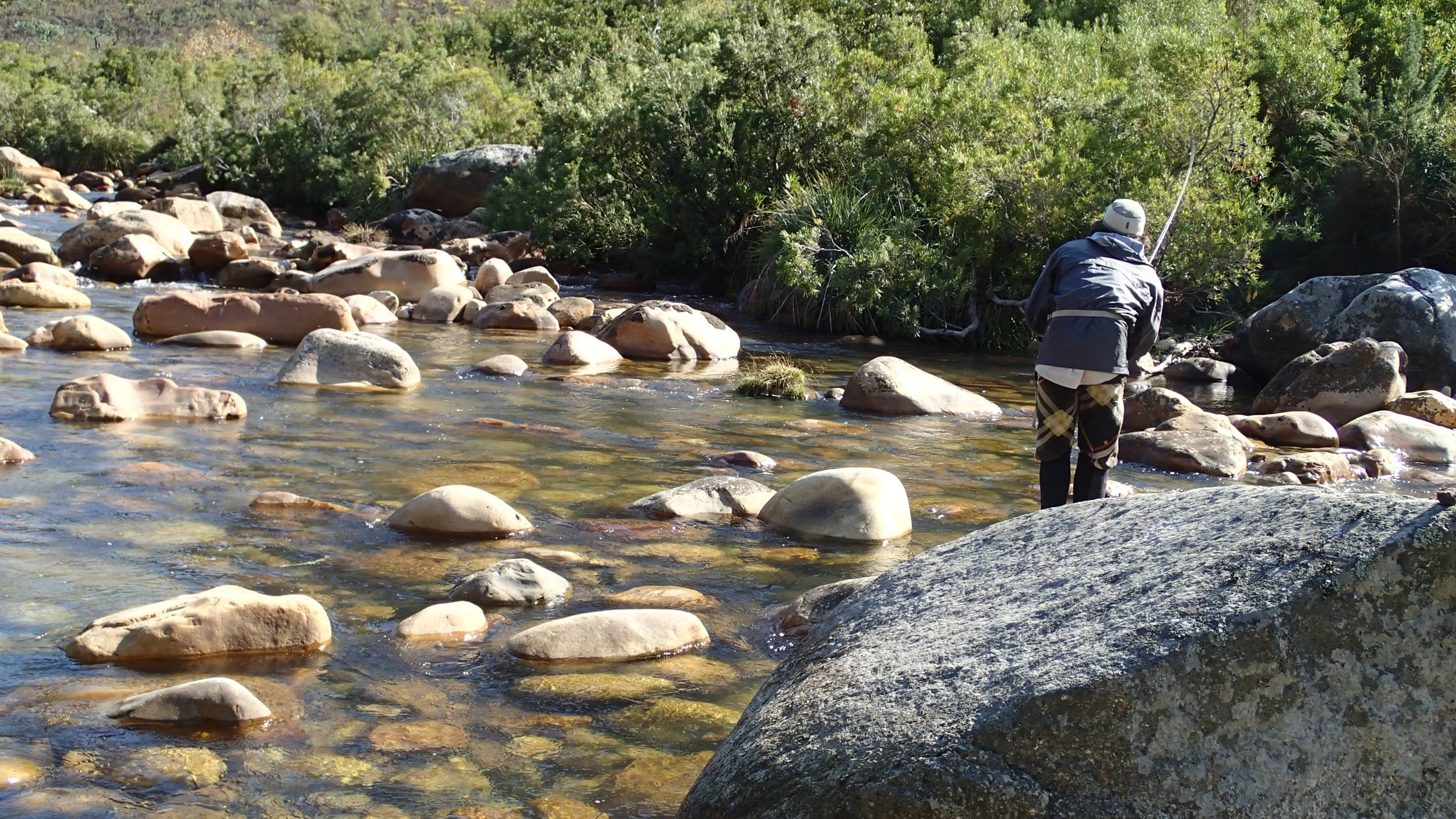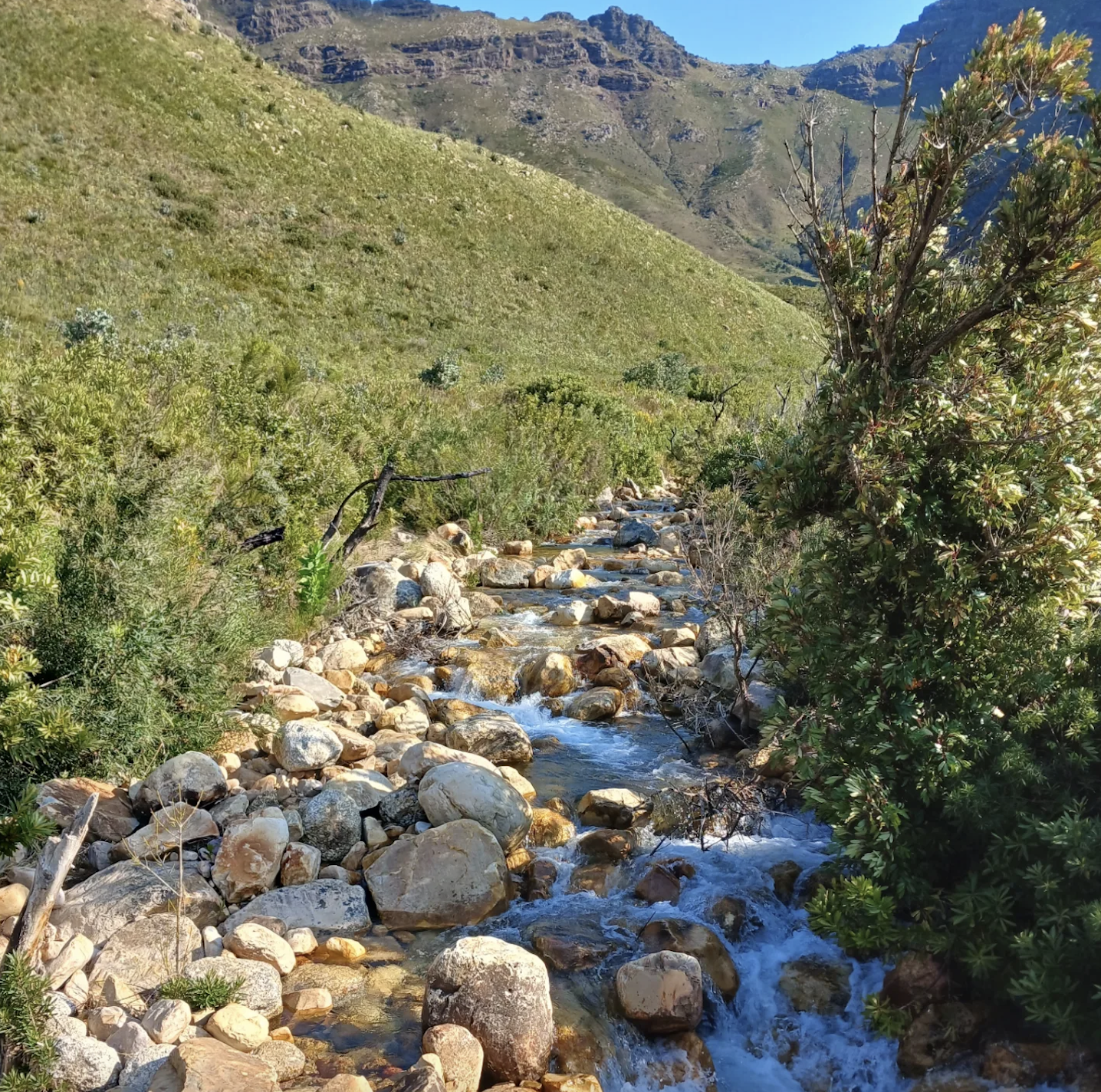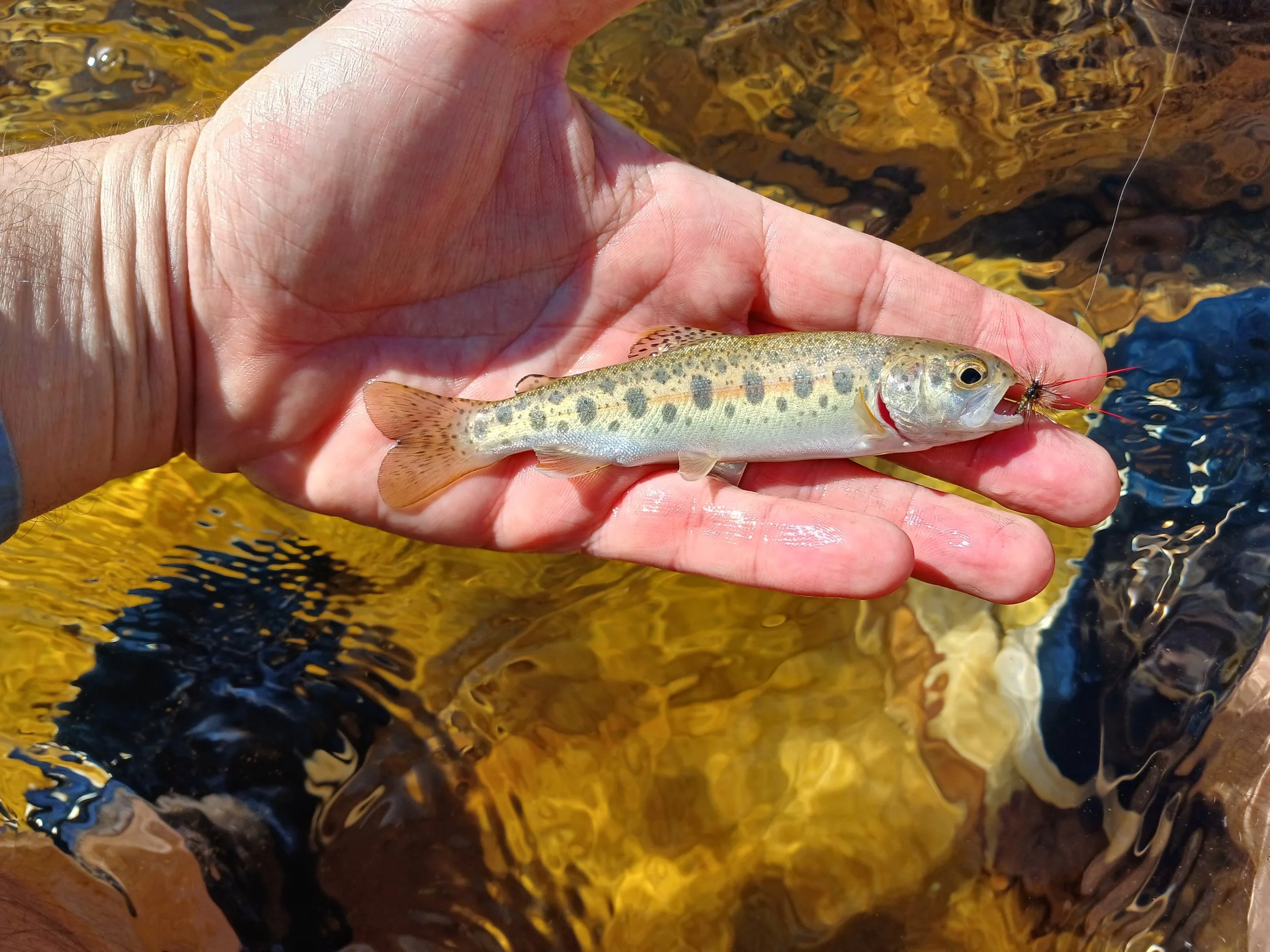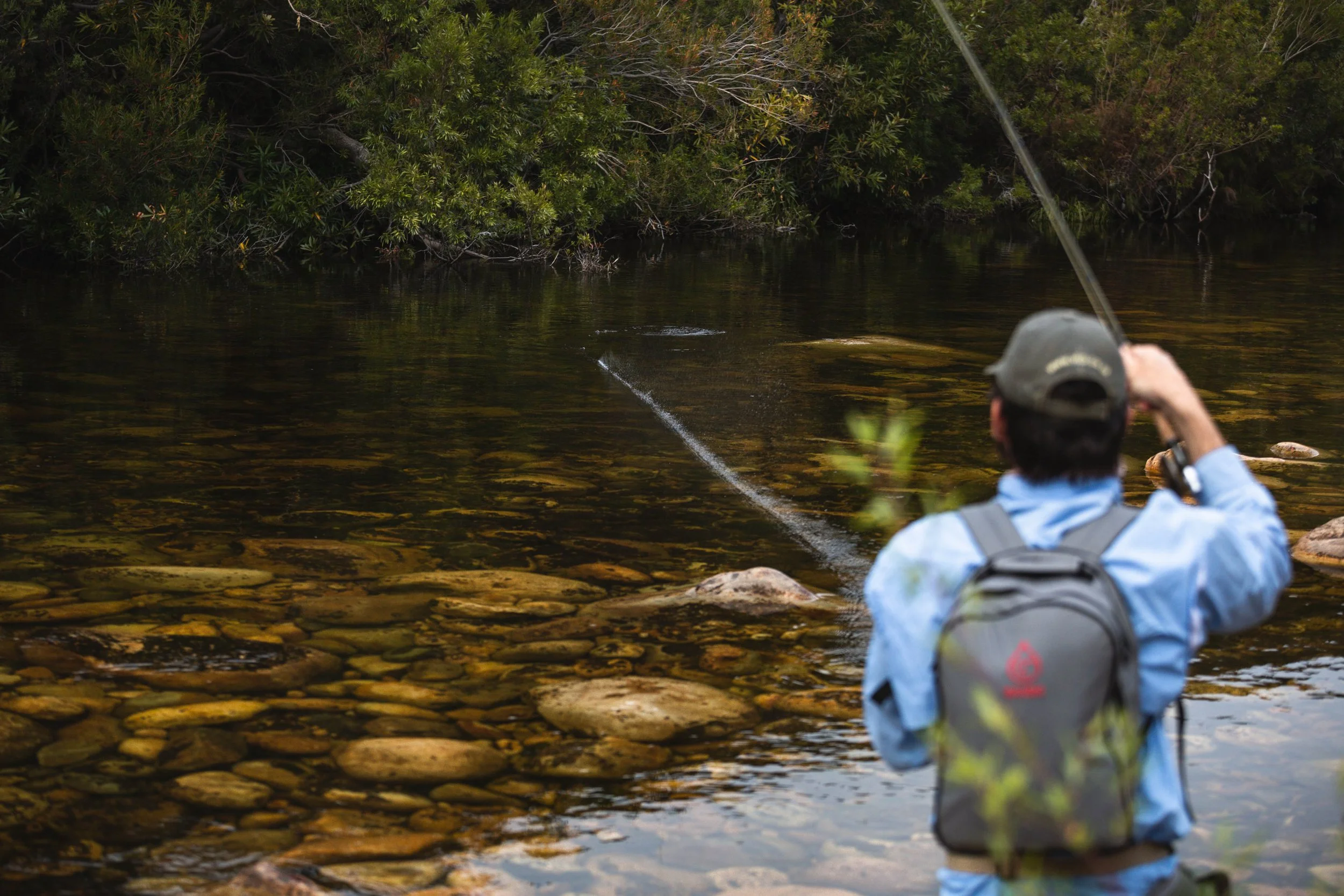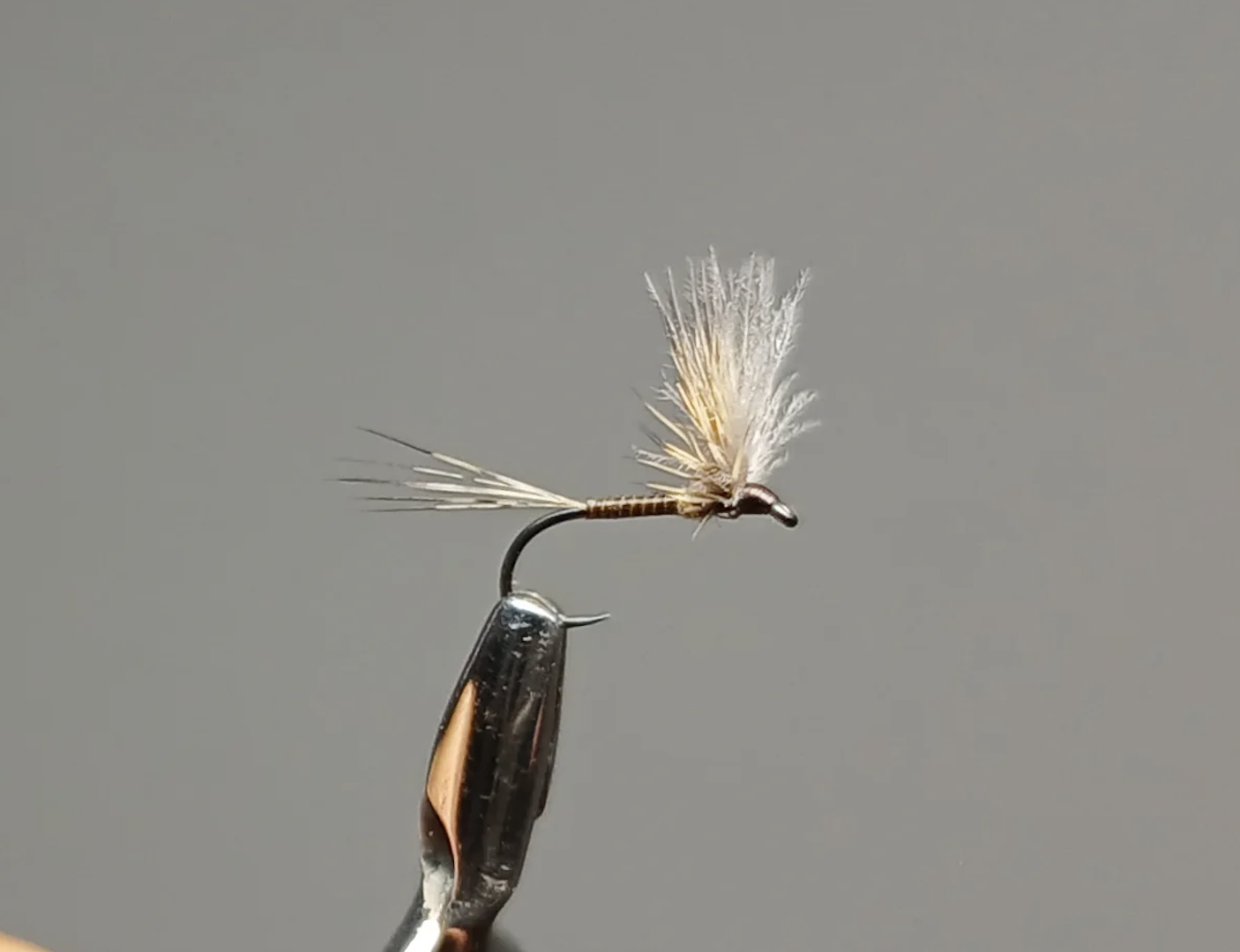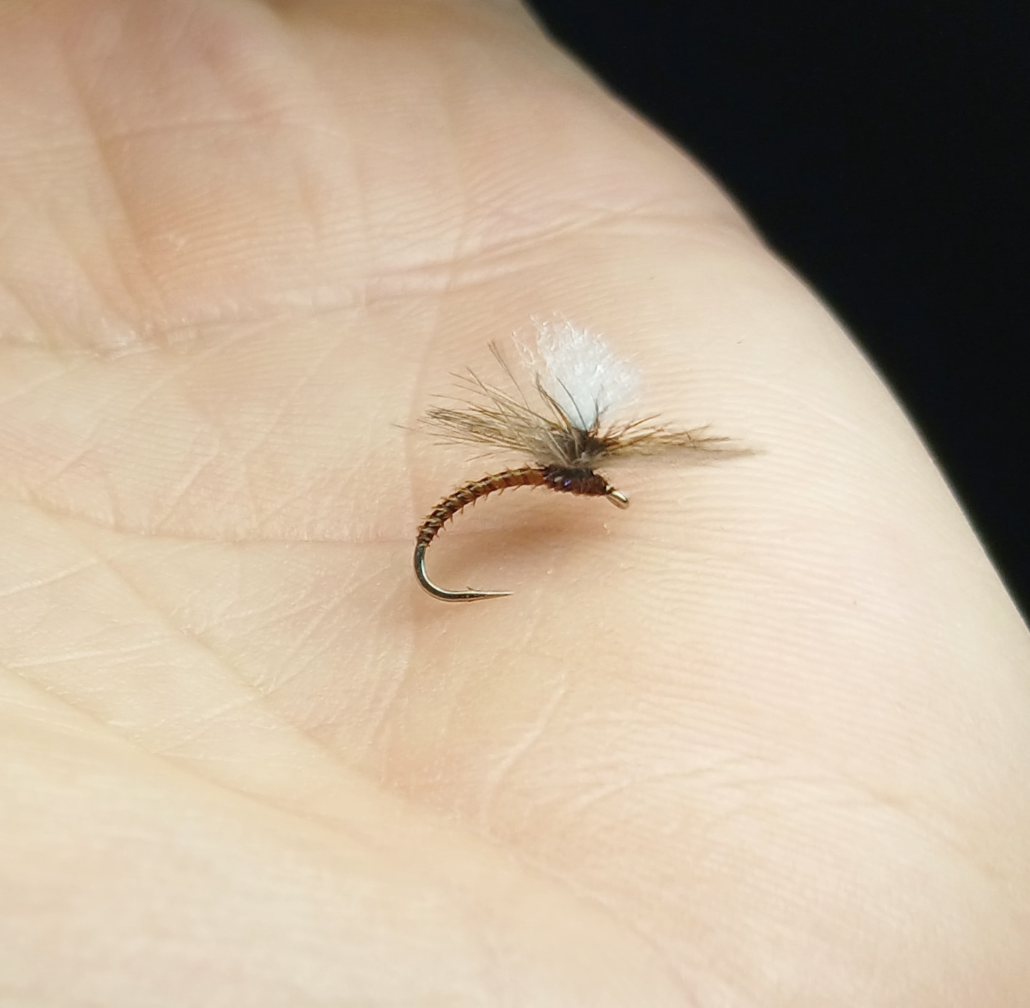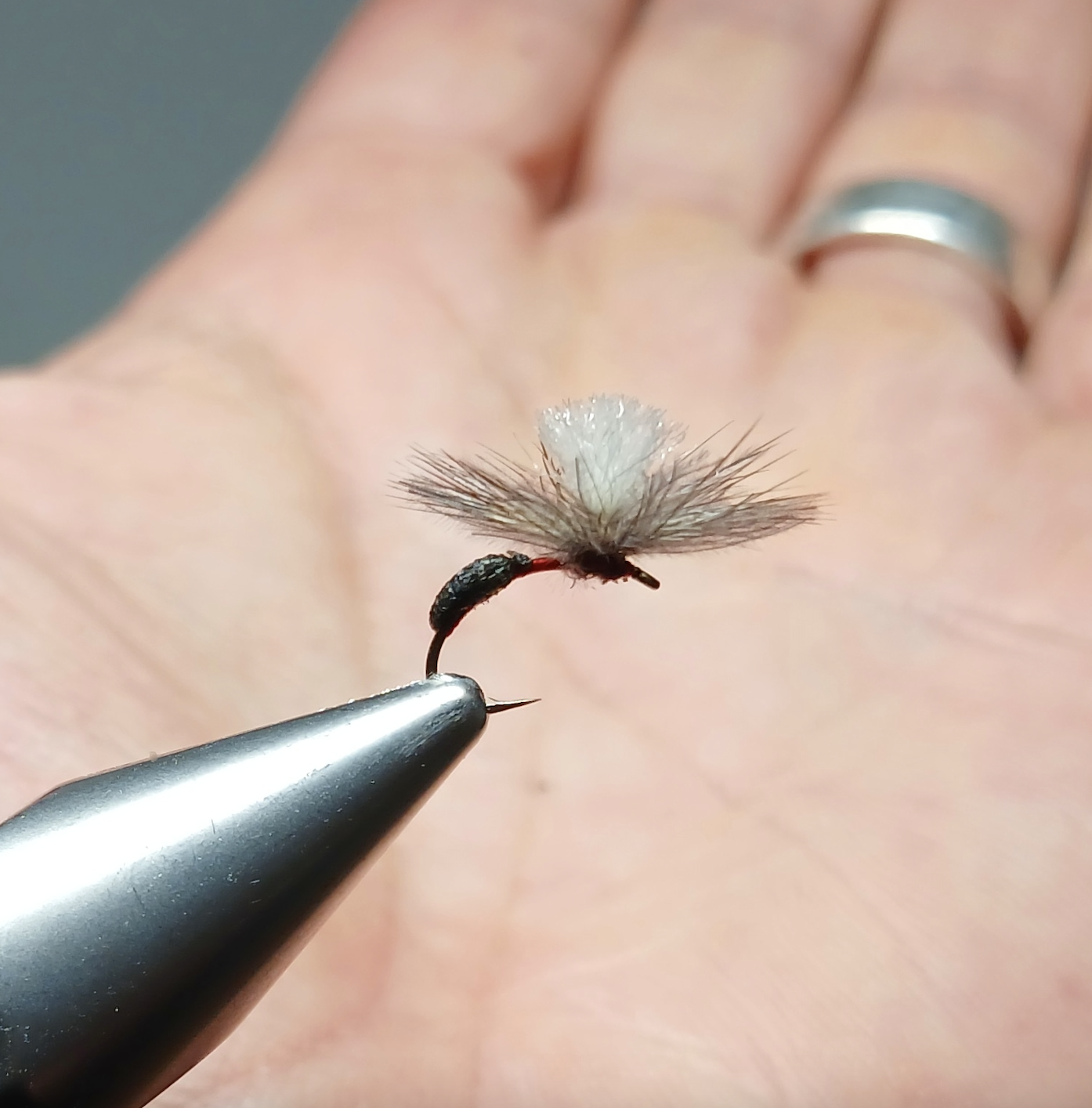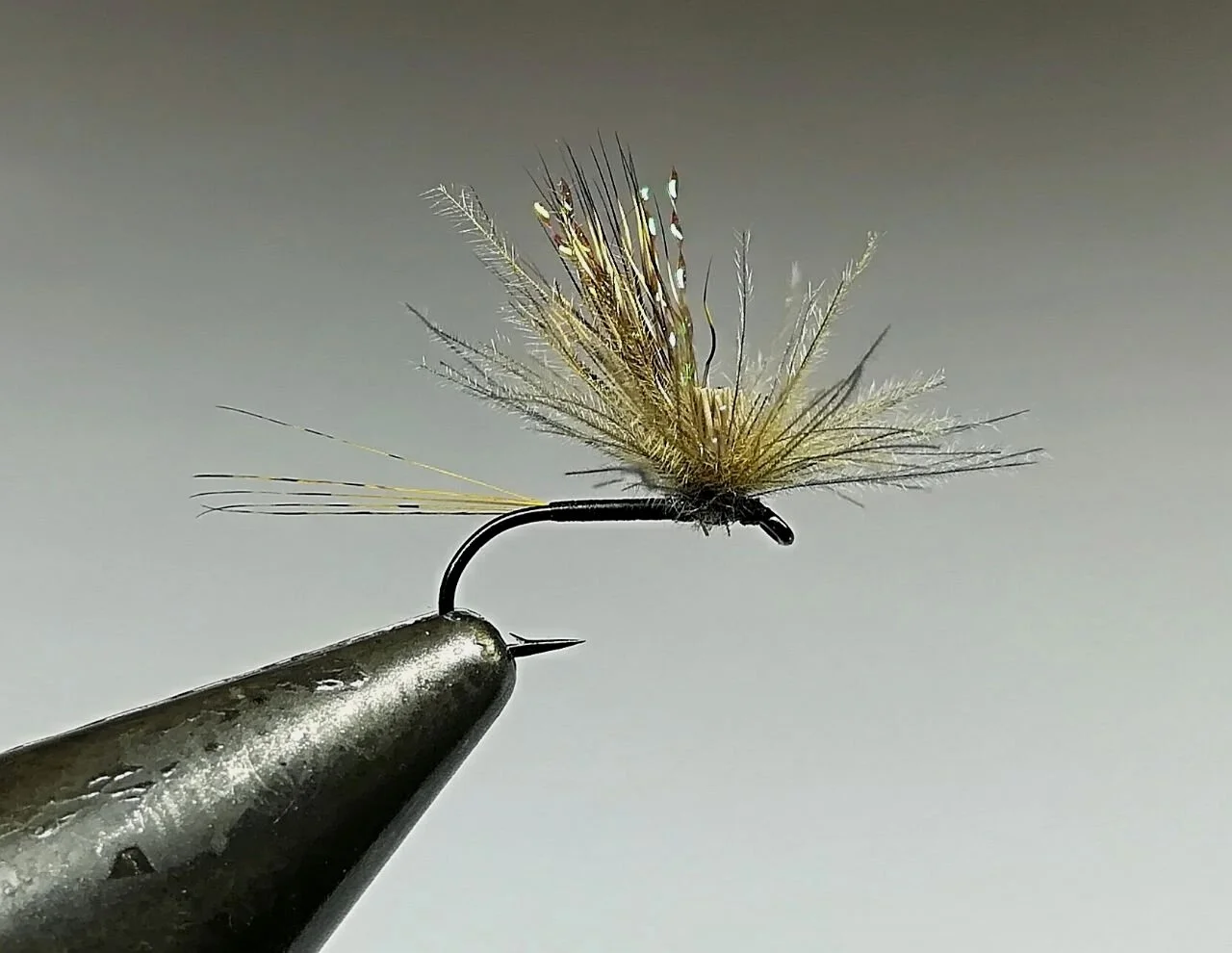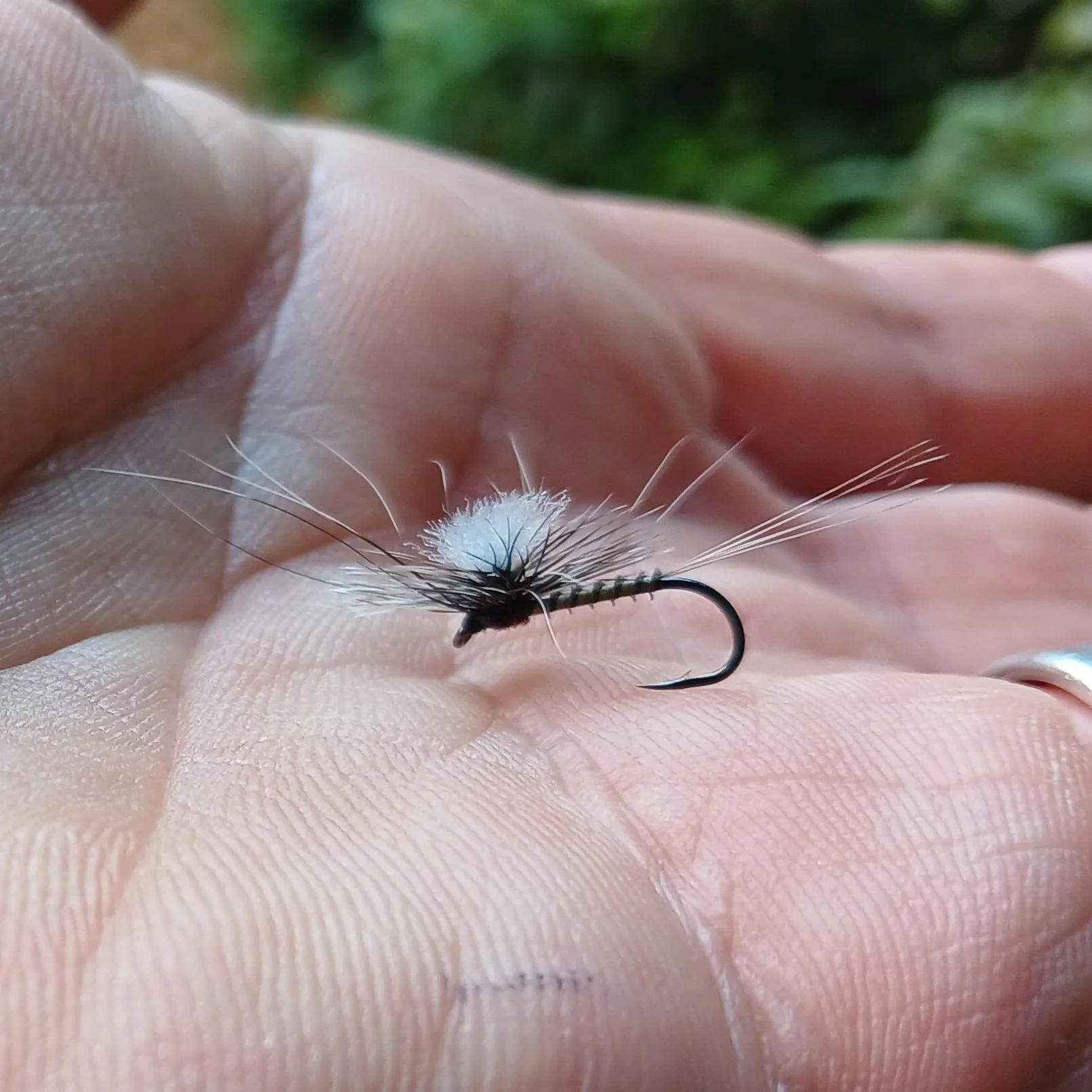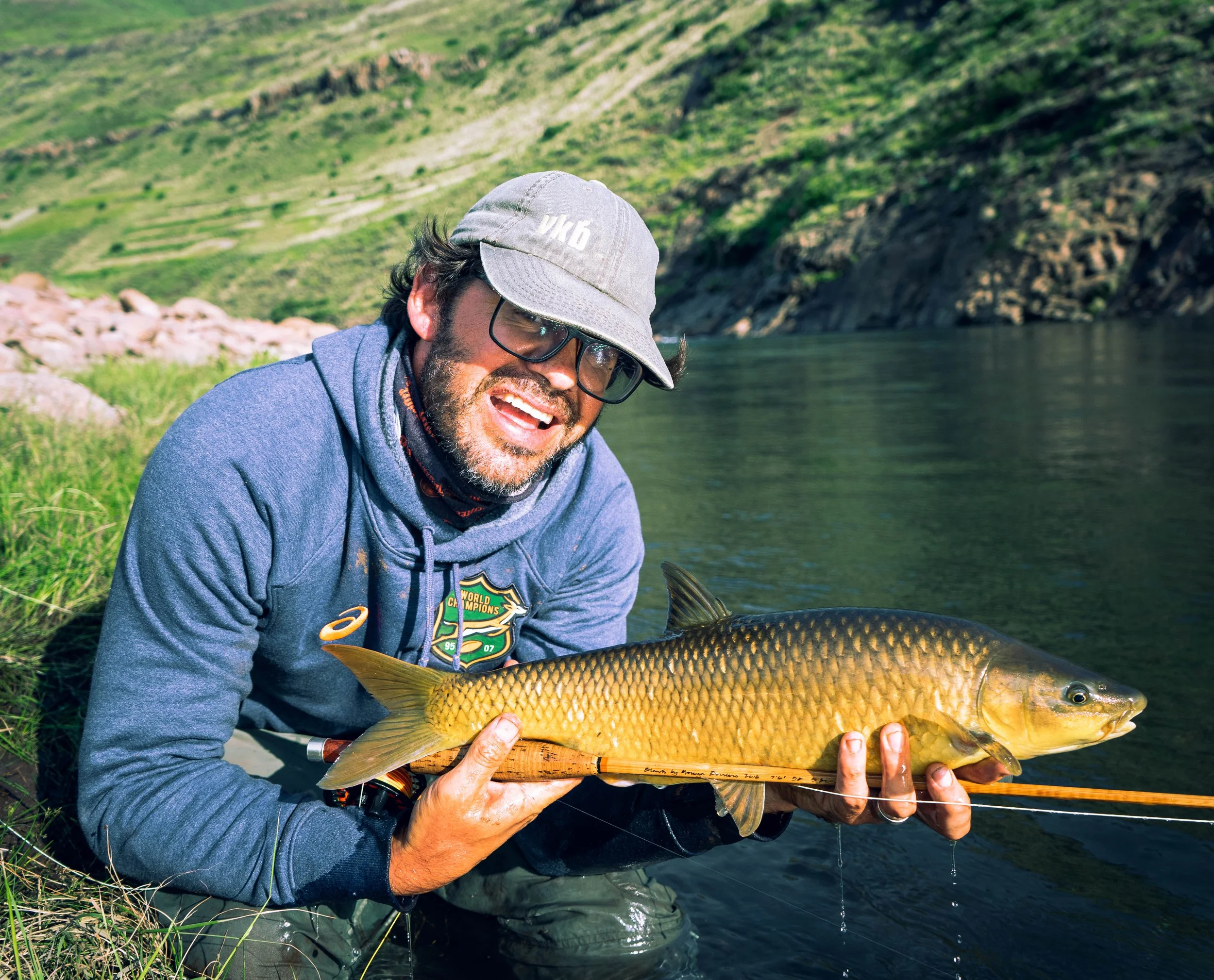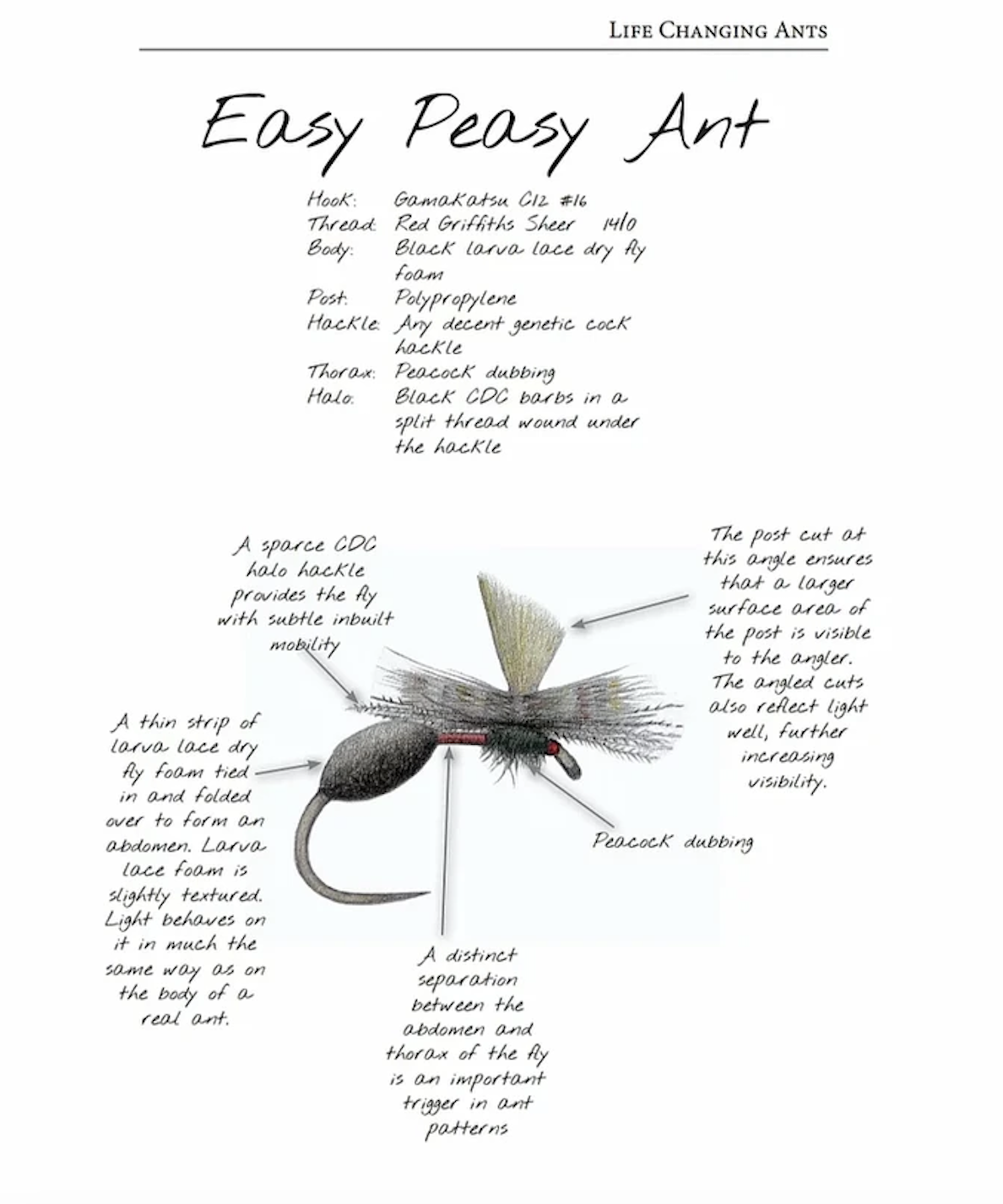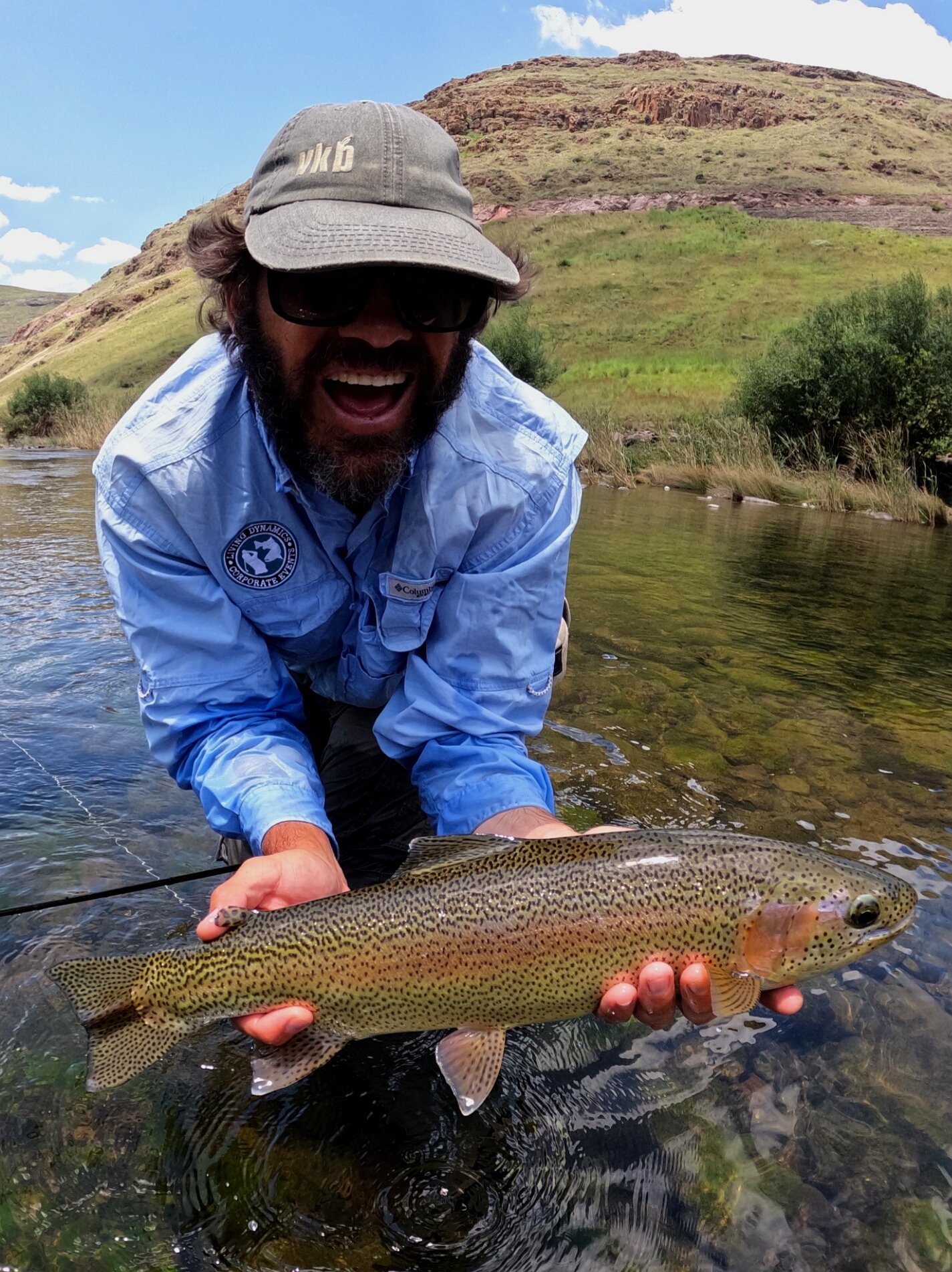
Gordon van der Spuy
1. Choice of equipment Rods, reels, fly lines, fly floatants, clothes, glasses, and other useful items.
I am a minimalist in the sense that I only carry what is absolutely essential. Every single piece of gear I have gets used. I like to be agile on a stream and don’t like anything on me that impedes my ease of movement.
To this end I carry a small waist bag ( moonbag) on me. In it is a small tube of C and F Powerfloat ( great floatant), a small bottle of Shimizaki dry shake for drying flies out, a small tub of self made mud ( fullers earth and dishwashing liquid mix) for taking the glare off my tippet , 4 spools of tippet, 5x, 6x, 7x and 8x Trouthunter mono. I also carry a spool of 7x trouthunter Fluorocarbon as well as a spool of 8x fluorocarbon. I also carry a fine long nosed plier for removing flies out of fish and a single small flybox with a few trustworthy patterns that have proven themselves over the years. I probably fish between 6 to 8 different patterns in a season. The reality is that if I can’t take them on any of those the fishing will be hellishly difficult anyway.
I have a small lightweight landing net attached to my backpack. This small backpack houses my lunch, tea and warm top. The African sun can be harsh so I am covered from head to toe In decent lightweight protective clothing.
My rod of preference is a 9ft 3 weight Echo dry fly rod or an Echo Shadow 2, which is actually a nymphing rod but works well for dry fly fishing too. For tight dense streams I use a 7’9 ft Orvis superfine touch 2 weight.
I’ve never understood the concept of people fishing small streams with short, stiff rods. They make line handling difficult and pop 7x tippets with ease. The Echo is not too fast and acts as a shock absorber protecting light tippets. I combine this with a 4w wf floating line to give me a bit of extra punch, useful as wind on our streams is more the rule than the exception.
2. Leader material, build-up, length and knots.
I generally fish a 14ft Trout Hunter leader tapering to 5X ( I’ve built leaders but now that I’m guiding just use Trouthunter leaders. These are great and take the hassle out of building leaders). Once I’ve attached tippet to this leader my leader setup is about 20ft long. These long, limp leaders combined with my 9ft rod make managing line easy. We don’t fish far out here. Our streams have many conflicting currents so short purposeful drag free presentations are an entry level requirement. Most of the time you don’t have any flyline out of the top eye of your rod, you’re just flicking the leader out most of the time. We literally don’t false cast.
My leader is attached to the fly line with a simple superglue splice, no knots or bulky loop to loop connections that can hinge. A smooth connection is necessary so that the line moves easily through the rod eyes as the leader is more than double the length of the rod. This connection also ensures a smooth transfer of energy from fly line to leader.
3. Approach and stealth.
In terms of approach I advocate a slow and purposeful attitude on stream. Plan the cast before you make it. Keep as low as possible and wear clothing that blends in with your environment. It takes one cast to catch a fish. One decent drift is more valuable than 10 shitty ones so take the time to plan your attack. The first cast on a section of water is always your best chance for success, make it count. Find the most direct route to present the fly without having to deal with conflicting currents that require one to excessively mend. Fail to plan and you’ll plan to fail. Also, any form of flash can spook fish on our streams so one needs to make sure that there are no flashing bits on ones tackle. Where I live people sand their rods down and paint rod eyes.
4. Reading the water.
Let the water and on stream conditions dictate how you fish it. Context has everything to do with how you approach a particular fish. A harsh downstream wind will require a different approach to an upstream wind or no wind. High water will often require bigger flies with larger profiles to get fish to make the effort to come up to them. Conversely, thin, slow water will often require smaller flies that are sparsely tied and that have some form of inbuilt mobility in them. In slower water fish have days to scrutinise a fly. Flies that behave like the real thing will often be simple suggestive patterns.
Fish will essentially position themselves where they can access food or protection easily. Our fish are user friendly in the sense that they generally occur where you expect them to be. This obviously can and does change depending on factors like water levels and angler pressure. The current hatch present or lack of one will also play a role in what you actually fish and how you fish it.
5. Casting ability which casts are essential.
I don’t do much casting in a day as I’m more often than not just flicking my fly into likely looking areas in the stream. I’ll fish the fly fairly close in, the more fly line on the water the more the chance of drag setting in. Our streams have many conflicting currents so keeping things simple and logic make sense. The most direct approach on our streams often turns out to be the most effective approach. The leader plays a massive role in terms of presentation and there should be enough slack in the system to ensure drag free drifts. When I guide clients I discourage excessive casting. Obviously most of the fishing I do is short range and this would change depending on the river or situation I find myself in.
6. Entomology, what should we know.
A basic knowledge of the bugs fish eat is important. Understanding their cycles and being aware of what is happening on stream is important. Tiny details make a huge difference. Being aware of what is happening in front of you is important. I spend a lot of time just observing. A lot of anglers are far too busy on the stream. Too much fishing and not enough planning. In many ways an angler is like a sniper. Plan the approach and then execute the approach. Nothing gives me more of a kick than watching a feeding fish, figuring out what it is eating, figuring out the optimal approach to hook the fish and then taking it on the first cast.
7. Rise forms Can they tell us something?
How a fish feeds will tell you a lot about what is happening on stream. To know this though, as mentioned before you need to spend time just watching what is going on around you. By spending time watching what fish do you’ll learn to understand their body language. Not all fish in the stream will always be feeding all the time. Hatches are obviously great for dry fly fisherman because they bring fish to the top and get them actively feeding. Funnily enough, I find opportunistic fish often easier to fool than fish feeding hard on the hatch. We don’t have intense hatches where I live so our approach is more general and more often than not, not that specific or hatch orientated. When hatches do occur our fish can get rather temperamental. They can still be taken but ironically it is often harder work taking them than when just normally prospecting with no hatch present. This is obviously not the case in other parts of the world. I often laugh when I get to a pool with a client and the fish are rising like the fish in a Disney cartoon with many fish simultaneously jumping clean out of the water. The culprit on our streams when this is happening is a small net veined midge. These midge hover above the water and the fish eat them in mid-air. The best way to take them when they’re like this ironically is to fish a drowned version of the adult. A small cdc soft hackle consisting of black thread and cdc barbs for the ‘hackle’ is particularly effective in this situation.
8. Fly selection, Size, shape, materials, which flies are essential.
I’m a firm believer in the concept of flies being functional implements. Essentially fish eat optimal presentations more than they do feather perfect flies. Flies need to be tied in such a way to facilitate this. Too many tiers are focussed on what the fly looks like. How the fly fishes should be of primary importance. How you go about tying the fly needs to be influenced by how you intend presenting the fly. Over the years I’ve simplified the way I tie opting for simple efficient patterns. I don’t fish many different flies and don’t need a whole truck full of materials either. All my stream tying materials can fit into one medium sized tool box. I tend to focus more on quality than quantity and like materials that are versatile.
Where I live most of our bugs are in the #18- #24 range with a #18 being the most common size fished. We occasionally get a larger March brown like mayfly in about a #12 or #14 that makes an appearance but this doesn’t happen often. Our bugs tend to be sparse and delicate looking. To this end I’m a firm believer in the concept of ‘less is more’. I’m supposed to be some hot shot flytyer but if you look at the box I fish with you’ll laugh. The flies in there are super basic often consisting of very little. Every material I tie onto the hook has a reason for being there.
The following patterns work for me 90% of the time
The Spunwing Dun ( An excellent all round mayfly dun or spinner imitation that will cover a wide range of natural depending on the materials used)
Hook: Gamakatsu S10 #14-#18
Thread: Griffiths sheer 14/0
Tail: Coq de Leon barbs (4- 6 depending on the size of the fly)
Body: Thread/ Biots/ stripped peacock herl (the materials used are dependent on the size and type of natural being imitated)
Wing: Fine Natural deer hair tied compara Dun style with CDC barbs ( trouthunter CDC is great) tied up front and flared with the wing. The deerhair provides the fly with structure enabling it to float well, the cdc barbs are there to provide the fly with subtle inbuilt mobility. This idea of combining stiffer materials with softer materials is a recurring theme in the flies I tie.
Best of Both Klink ( a great general emerger pattern)
Hook: Gamakatsu C12 B #14-#20
Thread: 14/0 Griffiths sheer
Body: A wild goose Biot ( colour dependant on naturals on stream
Post: polypropylene yarn
Hackle: genetic dry fly hackle
Thorax: Dubbing mix of choice ( I love squirrel)
Halo: Natural CDC ( Love the wild mallard CDC from Cookshill in the UK)
Easy Peasy Ant ( a good searching pattern , also does well in a hatch when they won’t eat imitations of the natural)
Hook: Gamakatsu C12 B #14-#18 ( love tying ants on curved hooks as you then get the abdomen submerged)
Thread: Griffiths sheer 14/0 in red, brown or black
Body: Larva lace dry fly foam.
Post: Polypropylene
Hackle: Genetic hackle of choice
Thorax: Fine dry fly dubbing in colour of choice
Halo: CDC barbs in a split thread tied in under the hackle.
CDC Tiltwing ( depending on how you tie it, it is an Excellent midge/ caddis/mayfly emerger pattern/general terrestrial)
Hook: Gamakatsu S10 #14-#18
Tail: CDL barbs
Body: Thread/Biots/stripped peacock herl
Wing: Fine deerhair
Thorax: Fine dry fly dubbing
Hackle: CDC barbs in a split thread wound as a parachute hackle around the base of the deer hair wing.
Easy Peasy Hopper ( Depending on how you tie it this is a great Stonefly/Cricket/Hopper pattern)
Hook:Tiemco 2302 #8-#12
Body, thorax and head: Larva lace dry fly foam
Underwing: CDC
Wing: Deerhair
Legs: Spanflex or silicone rubber
CDC Split wing ( excellent adult midge and micro mayfly pattern)
Hook: Standard dry fly hook #20 -#16
Tail: Split CDL barbs
Body: Thread
Sighter: Fluourescent red antron
Wings: CDC
Para RAB ( A larger than life early season pattern, also great for suspending small nymphs, great fast water fly. Also a great Cranefly imitation when lightly dressed)
Hook: Gamakatsu S10 #14-#18
Tail: Cdl barbs
Body: Biot
Post: Polypropylene
Hackle: Genetic hackle
Thorax: Fine dry fly dubbing
Halo: Grey Squirrel tail hairs and CDC in a split thread wound under the hackle.
CDC and ELK variant ( A nice mayfly emerger, also a great searching fly)
Hook: Gamakatsu S10 #14-#18
Tail: Cdl barbs
Body: CDC and squirrel dubbing mix in a split thread
Wing: Elk or deer
The Bug
Hook: Gamakatsu C12
Post: Pink Antron
Hackle:Grizzly
Halo: Cdc in a split thread wrapped under the hackle.
Good general guide fly. Easy to see, presents well and has inbuilt mobility.
10. Upstream or downstream?
Upstream or downstream depends on a few factors.
1. The wind
If the wind is blowing in a downstream direction and blowing hard sometimes the best course of action will be a downstream presentation.
2. The Fish
Sometimes fish are downright temperamental and will spook at the slightest hint of a tippet. The Henry’s Fork comes to mind where long limp leaders and downstream presentations are standard practise.
3. Access
It’s not always possible to present a fly upstream especially when fishing wild overgrown places.
If at all possible I opt for an upstream approach simply because it’s easier for me but will fish downstream when it’s called for.
11. Fighting fish.
I consistently take big yellowfish in excess of 7lbs on light tippets going down to 6X. The secret with playing big fish on light gear is the gear itself. The rod needs to act as a shock absorber to protect light tippets and the leader needs to have stretch in it to further aid this. Rod angles are important , you want as much of the rod bending as possible to ensure the pressure of the fish is equally distributed along the blank. To this end I'll often play fish with the rod to the side of my and not pointing directly up. I only apply as much pressure as necessary and won't try to antagonise the fish but will lead him or her around like a dog on a leash working with the fish and not against it. Surprisingly fights times are reduced by fighting the fish in a civilised manner.
I have a floating net, where the fish can rest while I get the camera ready, one quick photo with minimal handling and the fish is gently released. A fish will never be out the water for longer than say 20 seconds.
A picture of the floating net. The fish is always held over the net. If it falls no problem....
